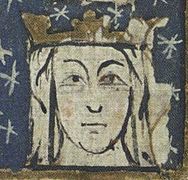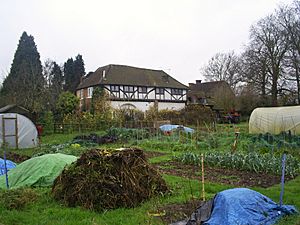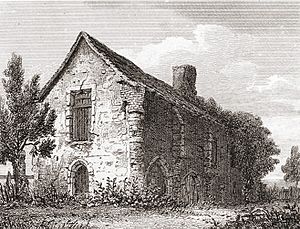Kings Langley Palace facts for kids
Quick facts for kids Kings Langley Palace |
|
|---|---|

Former site of Kings Langley Palace
|
|
| General information | |
| Status | Demolished |
| Type | Palace |
| Town or city | Kings Langley, Hertfordshire |
| Country | England |
| Coordinates | 51°42′43″N 0°27′32″W / 51.71194°N 0.45889°W |
| Estimated completion | 1277 |
| Demolished | 17th century |
Kings Langley Palace was a grand royal home built in the 1200s. It was located near the village of Kings Langley in England. For many years, kings from the Plantagenet family used it as a special place to live.
By the 1500s, the palace was no longer used and slowly turned into ruins. Today, you won't see any buildings left. Only some old foundations remain, which archaeologists study. The site is now protected as an important ancient monument.
History of Kings Langley Palace
The exact beginnings of Kings Langley Palace are a bit of a mystery. The land was once part of a huge forest. This forest stretched from London to Berkhamsted. It was full of deer, making it a great place for hunting. A small hunting lodge was already here during the time of King Henry III.
The land became royal property in 1276. Queen Eleanor of Castile, who was married to King Edward I, bought the estate. She then oversaw the building of a fancy royal home. Records from 1277 mention a "new start." This might mean they improved an old building or built a new one on top of the hill.
We don't know much about the palace's early days. But records from 1279-1281 show it had private rooms. These were for King Edward I, Queen Eleanor, and their son, Alphonso, Earl of Chester.
Kings Langley Palace was a family home for King Edward I and Queen Eleanor. Their son, Edward of Caernarfon, was born in 1284. He later became King Edward II. He spent much of his childhood at Langley Palace.
Prince Alfonso, who was supposed to be the next king, died just months after young Edward was born. Queen Eleanor also died unexpectedly in 1290. With Prince Edward now the heir, Langley Palace was set to be his.
After Eleanor's death, King Edward I moved to Ashridge. He held meetings of the Parliament there in 1290 and 1291. In 1299, the aging King Edward I married Margaret of France. He gave her Berkhamsted and Hertford Castles. He then returned to Langley.
That same year, he invited important people to celebrate a special day with him. These included the Bishop of Norwich, John Salmon, and John of Berkhamsted. They celebrated the feast day of All Saints with the King and Queen Margaret at Kings Langley.
When Prince Edward became Prince of Wales, King Edward I gave Langley to him in 1302. The young prince loved music, art, and horse racing. He also kept a small collection of animals at Langley, including a lion and a camel. He even let his close friend, Piers Gaveston, live with him at the palace. This friendship caused a lot of talk in England at the time.
In 1307, Edward II became king. In 1308, he started the nearby King's Langley Priory. This was a monastery built in the park next to the palace. It was here that King Edward reburied his friend Gaveston in January 1315, after Gaveston had been executed. Langley Palace remained the King's favorite home until he died in 1327. Today, there are no signs left of the monastery church or Gaveston's tomb.
During the time of King Edward III, his fifth son was born at Langley Palace in 1341. This son was Edmund of Langley, and he got his name from the manor. After Edmund died in 1402, he was buried in the priory there.
In the late 1340s, a terrible sickness called the Black Death swept through England. Many people died in London. So, King Edward III moved his royal court out of the city to Langley Palace in July 1349. For a short time, Kings Langley became the center of government. Edward also moved his large collection of religious relics from the Tower of London to Kings Langley for safety.
Geoffrey Chaucer, the famous writer of The Canterbury Tales, likely visited the palace. He worked for King Richard II as Clerk of the Kings Works between 1389 and 1391.
Later, King Richard II celebrated Christmas at the palace. The Palace was badly damaged by a fire in 1431. Records describe a "great and disastrous fire" at the manor. This fire was blamed on a musician's carelessness with a lit candle. However, later repair records show that the palace was not completely destroyed.
The last time the Palace was used for an official event was in 1476. William Wallingford, the Abbot of St. Albans, held a big dinner there. The guest was the Bishop of Llandaff.
The manor was given to Eton College but later returned to the Crown. King Henry VIII then gave it to Catherine of Aragon, whom he was about to marry. During Henry's rule, new types of landowners appeared. Instead of powerful lords, the king rewarded his loyal servants with land.
John Russell, 1st Earl of Bedford, was given charge of the royal park at Kings Langley in 1538. This was one of many rewards he received from King Henry VIII. The park was later bought by a rich lawyer, Sir Nicholas Bacon. He was an important official and built Old Gorhambury House near St Albans.
During the time of King Charles I, Kings Langley royal park was cleared for farming. Tenant farmers worked the land. By 1652, there were 10 farmers on the estate. In 1626, Charles I gave the Langley Estate to Sir Charles Morrison. He owned the Estate of Cassiobury nearby.
After Sir Charles Morrison died in 1628, the estate went to his daughter, Elizabeth Morrison, and her husband Arthur Capell, 1st Baron Capell of Hadham. Capell was a Royalist during the English Civil War. He was executed in 1649. The estate was then given to a Parliamentarian, Robert Devereux, 3rd Earl of Essex. After the king returned to power in the Restoration, the Langley Estate was given back to the Capell family. It went to Capell's son, Arthur Capell.
In the late 1600s, London's population grew. Landowners in the countryside started using their land more for farming. This was to provide food for the city. Many parks eventually disappeared. Kings Langley Park was not shown on a map from 1675.
The Langley Palace estate stayed with the Earls of Essex until 1900. The 7th Earl, George Capell, sold the land to a Mr. E. N. Loyd.
Parts of the Palace remained for many years after it stopped being a royal home. They slowly fell apart. The gatehouse and parts of the main building were still standing in 1591. In 1728, a historian wrote that "the rubbish of royalty exists" at Kings Langley. An illustration from 1816 shows a farm building. It was thought to include parts of the old palace, like the bake-house. A description from 1895 said that "only outer walls exist" of the palace.
Today, nothing remains of the royal palace. The site was once home to the Rudolf Steiner School, which closed in 2019. A small display of items found during digs was once in the school hall. Buildings from King's Langley Priory were also used by the Steiner School. Some old ruins are still in the area. Flint walls and stone pieces remain in a garden at 80, Langley Hill. These are thought to be from a house built for Sir Charles Morrisson around 1580.
Palace Architecture
The Palace was designed with three main courtyards. Records from 1279 to 1281 describe building work. This included rooms for the king, queen, and their son Alphonso. They also paved the queen's cloister, planted a vineyard, and dug a well. A moat around the palace was also made bigger.
Other records list the building of a new gateway (1282–83). A wine cellar was added (1291-92). Special openings called louvres were put on the hall roof. A stone wall was built around the court (1296–97). New fireplaces were also added in two "great chambers." The palace had a bath-house, kitchens, a bakery, and a roasting house. It also had a "long house."
Between 1359 and 1370, more additions were made. These included another bath house and a new entrance gate. This cost about £3000. A type of stone called Totternhoe Stone was used for the bath house and a fireplace in the King's room.
Digs in 1970 showed that the Palace had a huge underground wine cellar. This cellar is thought to have been built around 1291-92. It was on the west side of a kitchen courtyard. It was opposite a bakehouse. The digs also found a structure to the east. This is thought to be a gatehouse. This gatehouse opened onto a road, now called Langley Hill. Because the kitchens were on the west side, it's believed the palace's great hall ran from east to west.
Records show that a brickmaker for the king, William Veyse, was hired in 1437. His job was to make bricks for Kings Langley Palace. In 1440, bricks from a place called le Frithe were used. These were for fireplaces and ovens in the Palace. This might have been part of repairs after the 1431 fire. Veyse was also asked to supply bricks for a stone wall at the Tower of London in 1440.
In Literature
A scene in William Shakespeare's play Richard II takes place in the gardens of Kings Langley Palace. In Act III, scene IV, Queen Isabel learns that King Richard has been imprisoned.







